The incline dumbbell press is one of my all-time favorite chest exercises.
It trains all of your “pushing” muscles (pecs, shoulders, and triceps) simultaneously and allows you to move heavy weights, making it a time efficient way to build your upper body.
It’s a cut above many other chest exercises, too, because it’s particularly good at training your “upper chest”—the top portion of your pecs that helps produce that full, balanced, “armor plate” look that most guys aspire to.
The incline dumbbell bench press is also easy to learn and progressively overload, which is why it’s used to good effect in both novice and advanced training programs.
In this article, you’ll learn everything you need to know about how to do the incline dumbbell press correctly. You’ll also learn its benefits, how to avoid common mistakes, and how to do the best variations such as the incline dumbbell squeeze press and the low-incline dumbbell press.
Want to know exactly how you should train to reach your fitness goals? Take our free 60-second training quiz and find out now.
Key Takeaways
- The incline dumbbell press trains your chest, shoulders, and triceps, making it one of the best exercises for building upper-body muscle and strength
- It emphasizes the upper chest more than flat pressing variations, helping create a fuller, more balanced chest
- Using dumbbells allows for a greater range of motion, which enhances muscle activation and growth
- The incline dumbbell press also helps correct muscle imbalances by forcing each arm to lift the same load independently
- To get the most out of your incline pressing, train close to failure, strive to get stronger over time, and consider using supplements that support muscle growth and recovery like protein powder, creatine, and pre-workout.
Incline Dumbbell Press Benefits
The biggest benefit of the incline dumbbell press is it trains all of your “pushing” muscles, including the . . .
- Pectoralis major (both the sternocostal and clavicular heads)
- Anterior deltoid
- Triceps brachii
Here’s how the muscles worked by the incline dumbbell press look on your body:
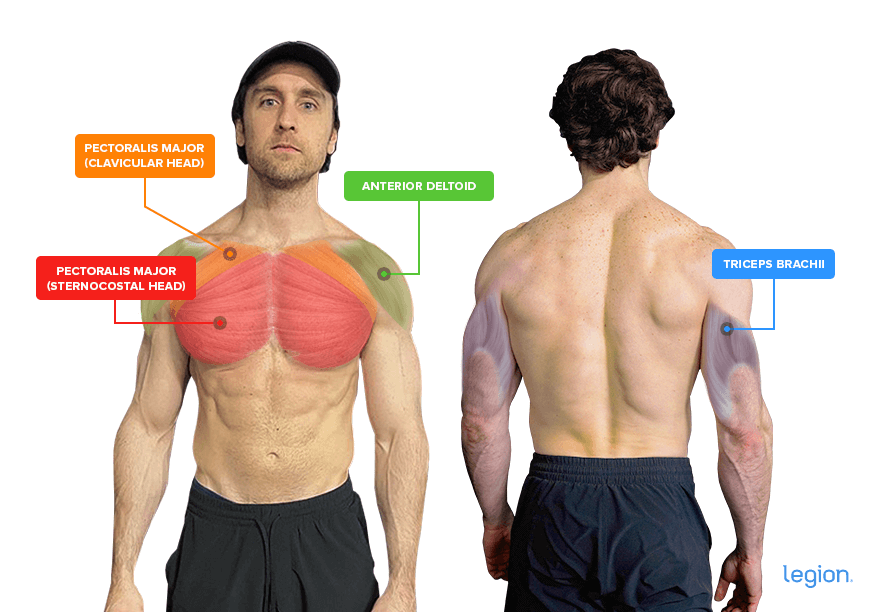
That said, there are three reasons the incline dumbbell bench press is uniquely beneficial compared to other pressing exercises . . .
1. It can help correct muscle imbalances.
The incline dumbbell press helps correct muscle imbalances in two ways:
- As both sides of your body must lift the same amount of weight independently, it prevents one side from growing stronger than the other. In other words, one side can’t “take over” or “pick up slack,” which can happen with the barbell bench press.
- It emphasizes the clavicular head of the pecs, which helps ensure your “upper” chest development doesn’t lag behind your “lower” chest. Although I’m not aware of any studies on the incline dumbbell press in particular, research shows the incline barbell bench press is effective in this regard, and there’s no reason to think you wouldn’t get similar results from the dumbbell variation.
2. It trains the pecs as well as the flat barbell bench press.
The flat barbell bench press is widely considered to be the best exercise for gaining chest muscle and pressing strength, and this is basically true.
You can lift about 20% more weight when you bench press with a barbell than when you use dumbbells, which makes it one of the most effective ways to progressively overload your chest muscles.
That said, the dumbbell bench press (both flat and incline variations) are no slouch in this regard, either.
Research shows that the dumbbell bench press activates your pecs slightly more than the barbell bench press, which at least partially makes up for the fact you can’t lift as much weight. It’s also reasonable to assume that this would hold true for the incline variations of both exercises, too.
Now, while muscle activation isn’t the same as muscle growth, this is still evidence that the incline dumbbell press isn’t significantly less effective than the incline barbell press for gaining chest mass. In other words, you can think of these two exercises as more or less interchangeable.
3. It allows for a greater range of motion than many other chest exercises.
Research shows that muscles tend to grow more when they’re trained through a full range of motion and a stretched position.
However, when you use a barbell, your range of motion with some exercises is limited by the bar. For example, when you do the barbell bench press, you have to stop each rep when the bar touches your chest, even though you could probably lower your hands a few more inches without problem.
You aren’t restricted by a bar when you do the dumbbell bench press, though, which allows you to use a greater range of motion and stretch your pecs more in each rep. This too helps offset the weight-related disadvantage of dumbbell pressing.
Incline Dumbbell Press vs. Flat Dumbbell Press
The main difference between the incline dumbbell press and the flat dumbbell press is that the incline dumbbell press emphasizes the smaller clavicular (upper) head of the pecs, whereas the flat dumbbell press emphasizes the larger sternocostal (lower) head.
Thus if you want well-developed, proportionate pecs, it makes sense to include a mix of incline and flat pressing in your workout routine.
(This is exactly what you’ll find in my Bigger Leaner Stronger program for men, and Thinner Leaner Stronger program for women.)
How to Do the Incline Dumbbell Press
Before we get into the specifics of incline dumbbell press form, make sure you have all the equipment you need to do the incline dumbbell bench press, including . . .
- A pair of dumbbells
- A sturdy incline bench (ideally an adjustable one)
- A pair of weightlifting wrist wraps and a weightlifting belt (optional)
Research shows the best angle for the incline dumbbell press is about 45 degrees if you want to emphasize your upper chest, though higher and lower angles are also effective. Lowering the angle will emphasize your lower chest, and increasing the angle will emphasize your shoulders.
Thus, I recommend that you start with a 45-degree angle and only lower it if this position feels uncomfortable or like it’s mainly training your shoulders and not your chest.
Step 1: Set up
Adjust a bench to between 30 and 55 degrees (45 degrees is a good starting point). Grab a dumbbell in each hand, sit on the bench, and rest the dumbbells on your thighs.
Lie back, hoisting the dumbbells up so you’re holding them on either side of your chest by giving them a nudge with your thighs.
Arch your back slightly, plant your feet on the floor, raise your chest, and tuck your shoulder blades down and squeeze them together. A good cue for this is to think of pulling your shoulder blades into your back pockets, like this:
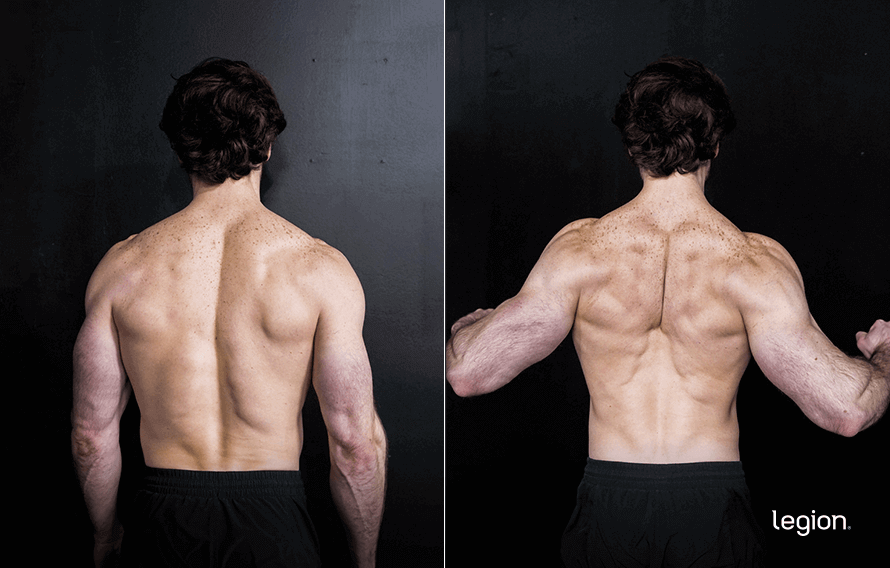
Step 2: Press
Push the dumbbells toward the ceiling. As they rise, allow them to drift closer together (some people like to touch them at the top of each rep, but this isn’t necessary). At the top of the rep your elbows should be almost locked and the dumbbells should be 1-to-2 inches apart or barely touching.
Remember to keep your shoulder blades “down and back,” your elbows about 6-to-12 inches from your torso, your lower back slightly arched, your butt on the bench, and your feet on the floor.
Step 3: Descend
Reverse the movement and lower the dumbbells to either side of your chest. You should feel a deep stretch in your pecs and the handles of the dumbbell should be level with your upper chest—about an inch lower than your collarbone.
Incline Dumbbell Press Form Mistakes
Overarching your back.
The problem: To set up correctly for any horizontal pressing exercise, you have to slightly arch your back. If you arch your back too much while doing the incline dumbbell press, though, you change the angle of the exercise, making it more like a flat dumbbell press, negating some of the unique benefits (emphasizing your upper chest, mainly). Many people also lift their butt off the bench which exacerbates the problem.
The fix: Set up for the incline dumbbell press and then have a training partner put their hand in the space between the bench and your arched back. If they can barely make a fist, your arch is fine. If they can make a fist with room to spare, you’re overarching your back and you should flatten it slightly.
Not pressing the dumbbells straight up.
The problem: Many people naturally press dumbbells in the same direction as their gaze, and as we tend to look forward when incline pressing, not up at the ceiling, the dumbbells can deviate from an optimal straight-up-and-down path to a curved one. This wastes energy and saps strength.
The fix: Set up for the incline dumbbell press with the back of your head pressed against the bench. Gaze at the ceiling, then press in the direction you’re looking.
Touching the dumbbells too low on your chest.
The problem: A common cue for the flat barbell bench press is to lower the bar until it touches your mid to lower chest. Many people use the same cue with the dumbbell incline press, and wind up touching the dumbbells too low, which makes the exercise awkward (and even painful) and reduces strength.
The fix: When performing the incline dumbbell press, imagine the handles are connected by a piece of string. As you lower the dumbbells, try to lay the (imaginary) string across your upper chest, about an inch below your collarbone.
The 5 Best Incline Dumbbell Press Variations
Incline Dumbbell Shoulder Press

How to: While sitting on a bench that’s angled at about 70 degrees, hold a dumbbell in each hand and rest them on your thighs. Hoist the dumbbells up so you’re holding them just above your shoulders with your palms facing away from you, nudging them with your thighs to get them into position.
Press the dumbbells straight up toward the ceiling until your arms are straight and your elbows are almost locked. Then lower the dumbbells to the starting position.
Incline Dumbbell Squeeze Press
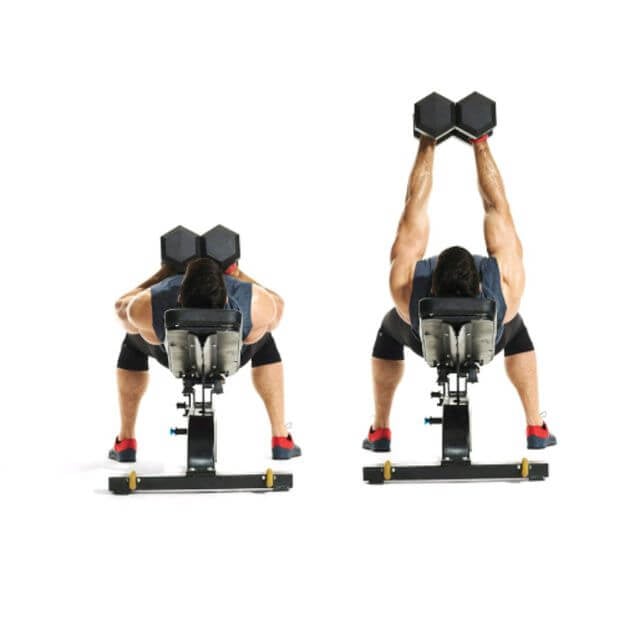
How to: While sitting on a bench that’s angled at 45 degrees, hold a dumbbell in each hand and rest them on your thighs. Hoist the dumbbells up so you’re holding them just above the middle of your chest with your palms facing each other and the dumbbells pressed together, nudging them with your thighs to get them into position.
While keeping the dumbbells squeezed together throughout the entire rep, press the dumbbells straight up toward the ceiling until your arms are straight and your elbows are almost locked. Then lower the dumbbells to the starting position.
Low-Incline Dumbbell Press
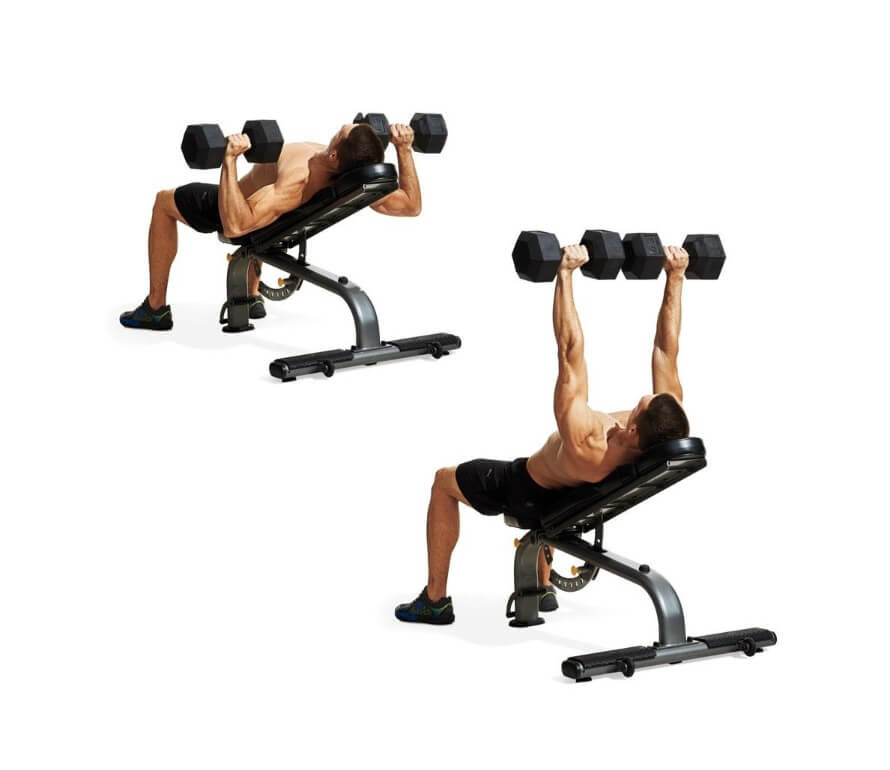
How to: While lying on a bench that’s angled at 15-to-30 degrees, hold a dumbbell in each hand and rest them on your thighs. Lie back, hoisting the dumbbells up so you’re holding them on either side of your chest by nudging them with your thighs to get them into position.
Press the dumbbells straight up over your upper chest until your arms are straight and your elbows are almost locked. Then lower the dumbbells to the starting position.
Reverse-Grip Dumbbell Press

How to: While sitting on a flat bench, hold a dumbbell in each hand and rest them on your thighs. Lie back and bring the dumbbells up so you’re holding them with a neutral grip (palms facing each other) on either side of your chest by nudging them with your thighs to get them into position.
Press the dumbbells straight up over your chest until your arms are straight and your elbows are almost locked. As you press, rotate your wrists so that at the top of the rep, your palms are pointing in the same direction as your head. Then lower the dumbbells to the starting position.
Note: You’ll often see people try to increase the effectiveness of the reverse-grip dumbbell press by combining it with the incline dumbbell press to make the reverse-grip incline dumbbell press.
This doesn’t make the exercise any more effective, though, so there’s no need to include the reverse-grip incline dumbbell press in your routine if you’re already doing the incline dumbbell press or the reverse-grip dumbbell press. The exercise also tends to be awkward and limit how much you can press, making it less effective overall.
Landmine Press
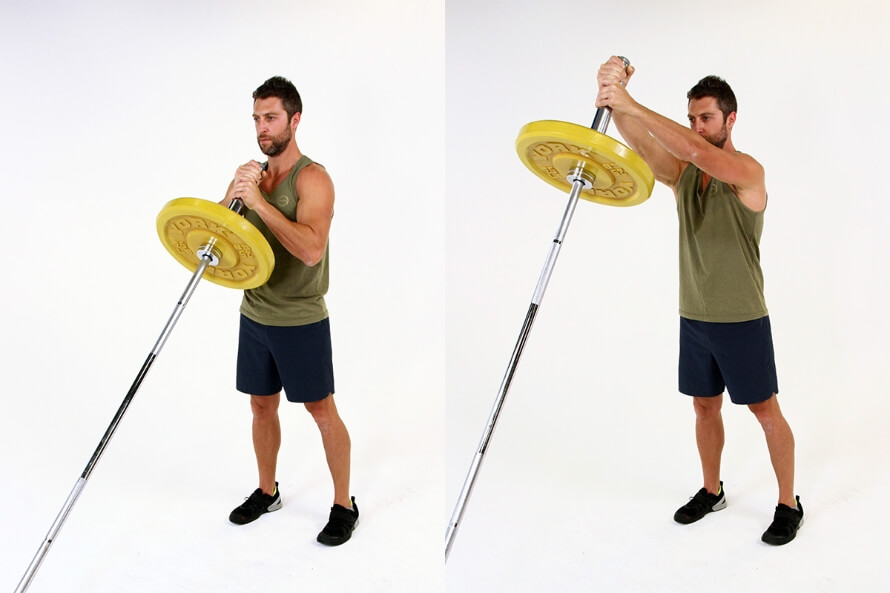
How to: Place one end of an empty barbell in a landmine attachment or wedge it into the corner of the room and load the other end with weight plates. While standing up straight and facing the weighted end of the barbell, hoist the barbell up to chest height and grip it with a neutral grip (palms facing each other), with one hand above the other.
Press the barbell away from your chest until your arms are straight and your elbows are almost locked, then reverse the movement and return to the starting position.
Supplements to Maximize Your Chest Training
The incline dumbbell press is a fantastic upper-body builder, but your results ultimately depend on more than just good exercise selection—you also need to train hard, recover well, and fuel your body properly.
Here are three supplements that can help you get the most out of your incline pressing:
- Protein powder: Protein powder, such as whey or casein, provides your body with the nutrients needed to build muscle tissue and recover from workouts. For a clean and delicious protein powder, try Whey+ or Casein+.
- Creatine: Creatine boosts muscle and strength gain, improves anaerobic endurance, and reduces muscle damage and soreness from your workouts. For a natural source of creatine, try our creatine monohydrate, creatine gummies, or Recharge.
- Pre-workout: A high-quality pre-workout enhances energy, mood, and focus, increases strength and endurance, and reduces fatigue. For a top-tier pre-workout containing clinically effective doses of 6 science-backed ingredients, try Pulse with caffeine or without.
(If you’d like even more specific advice about which supplements you should take to reach your health and fitness goals, take the Legion Supplement Finder Quiz, and in less than a minute, you’ll know exactly what supplements are right for you.)
Scientific References +
- Trebs, A. A., Brandenburg, J. P., & Pitney, W. A. (2010). An electromyography analysis of 3 muscles surrounding the shoulder joint during the performance of a chest press exercise at several angles. Journal of Strength and Conditioning Research, 24(7), 1925–1930. https://doi.org/10.1519/JSC.0b013e3181ddfae7
- Lauver, J. D., Cayot, T. E., & Scheuermann, B. W. (2016). Influence of bench angle on upper extremity muscular activation during bench press exercise. European Journal of Sport Science, 16(3), 309–316. https://doi.org/10.1080/17461391.2015.1022605
- Trebs, A. A., Brandenburg, J. P., & Pitney, W. A. (2010). An electromyography analysis of 3 muscles surrounding the shoulder joint during the performance of a chest press exercise at several angles. Journal of Strength and Conditioning Research, 24(7), 1925–1930. https://doi.org/10.1519/JSC.0b013e3181ddfae7
- Oranchuk, D. J., Storey, A. G., Nelson, A. R., & Cronin, J. B. (2019). Isometric training and long-term adaptations: Effects of muscle length, intensity, and intent: A systematic review. In Scandinavian Journal of Medicine and Science in Sports (Vol. 29, Issue 4, pp. 484–503). Blackwell Munksgaard. https://doi.org/10.1111/sms.13375
- Kubo, K., Ikebukuro, T., & Yata, H. (2019). Effects of squat training with different depths on lower limb muscle volumes. European Journal of Applied Physiology, 119(9), 1933–1942. https://doi.org/10.1007/s00421-019-04181-y
- McMahon, G. E., Morse, C. I., Burden, A., Winwood, K., & Onambélé, G. L. (2014). Impact of range of motion during ecologically valid resistance training protocols on muscle size, subcutaneous fat, and strength. Journal of Strength and Conditioning Research, 28(1), 245–255. https://doi.org/10.1519/JSC.0b013e318297143a
- Bloomquist, K., Langberg, H., Karlsen, S., Madsgaard, S., Boesen, M., & Raastad, T. (2013). Effect of range of motion in heavy load squatting on muscle and tendon adaptations. European Journal of Applied Physiology, 113(8), 2133–2142. https://doi.org/10.1007/s00421-013-2642-7
- Schoenfeld, B. J., & Grgic, J. (2020). Effects of range of motion on muscle development during resistance training interventions: A systematic review. SAGE Open Medicine, 8, 205031212090155. https://doi.org/10.1177/2050312120901559
- Farias, D. D. A., Willardson, J. M., Paz, G. A., Bezerra, E. D. S., & Miranda, H. (2017). Maximal Strength Performance and Muscle Activation for the Bench Press and Triceps Extension Exercises Adopting Dumbbell, Barbell, and Machine Modalities over Multiple Sets. Journal of Strength and Conditioning Research, 31(7), 1879–1887. https://doi.org/10.1519/JSC.0000000000001651
- Saeterbakken, A. H., van den Tillaar, Ro., & Fimland, M. S. (2011). A comparison of muscle activity and 1-RM strength of three chest-press exercises with different stability requirements. Journal of Sports Sciences, 29(5), 533–538. https://doi.org/10.1080/02640414.2010.543916
- Trebs, A. A., Brandenburg, J. P., & Pitney, W. A. (2010). An electromyography analysis of 3 muscles surrounding the shoulder joint during the performance of a chest press exercise at several angles. Journal of Strength and Conditioning Research, 24(7), 1925–1930. https://doi.org/10.1519/JSC.0b013e3181ddfae7










